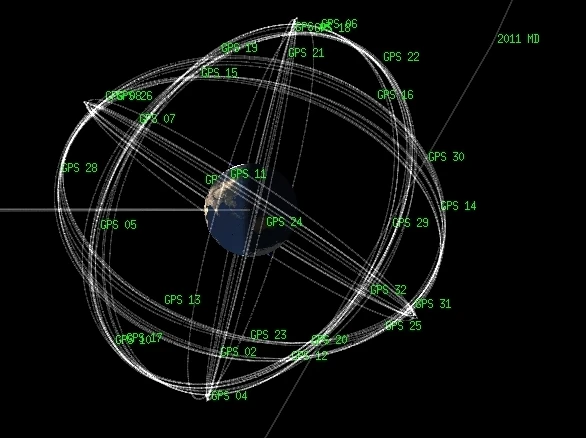Last update: October 2, 2025
urin Scale: A Classification System for Impact Risks
Image description: The Torino Scale is a system for classifying the impact risks of asteroids and comets on Earth. It ranges from 0 (no risk) to 10 (certain collision with catastrophic effects). As shown in this simulated image, the asteroid 2011 MD (top right) passed inside the orbits of the 31 GPS satellites. Its distance from Earth was only 12,300 kilometers. Its trajectory was strongly curved by Earth's gravity and then it continued its journey around the Sun.
What is the Torino Scale?
The Torino Scale is a tool used by astronomers to assess the impact risks of asteroids and comets on Earth. It was created in 1999 by Professor Richard P. Binzel of the Massachusetts Institute of Technology (MIT) and is named after the Italian city of Turin, where it was first presented.
This scale ranges from 0 to 10, where 0 indicates no risk or negligible risk, and 10 represents a certain collision with catastrophic global consequences. The scale considers two main factors: the probability of impact and the kinetic energy of the object.
The Torino Scale is divided into categories
The Torino Scale is divided into four main categories:
- White (0): No risk of impact.
- Green (1): Extremely low probability of impact.
- Yellow (2-4): Events warranting increased attention but unlikely to impact Earth.
- Orange (5-7): Serious threat requiring continuous monitoring.
- Red (8-10): Certain impact with devastating consequences.
Examples of Asteroids
Several asteroids have come close to Earth or are expected to do so in the future.
- 1950 DA: Has a very low but notable probability of impact in 2880.
- 1979 XB: Has an orbit that crosses Earth's orbit with a theoretical risk in 2056.
- Bennu (101955 Bennu): Discovered on September 11, 1999, by the LINEAR project (Lincoln Near-Earth Asteroid Research). This asteroid, studied by NASA's OSIRIS-REx mission, has a low probability of impacting Earth in 2182. It is currently classified at level 1.
- 2000 SG344: A small asteroid with a possibility of impact in 2071.
- Apophis (2004 MN4): Discovered in 2004, this asteroid was initially classified at level 4 on the Torino Scale due to a risk of impact in 2029. Subsequent observations reduced this risk to 0.
- 2006 JY26: A small asteroid whose orbit regularly crosses Earth's orbit.
- 2008 OS7: Closely monitored asteroid with a close approach expected in 2045.
- 2011 AG5: Was closely tracked after its discovery due to its initial trajectory presenting a slight risk of impact in 2040.
- 2015 RN35: Considered a potentially hazardous asteroid with regular close approaches.
- 2019 OK: This asteroid came close to Earth in July 2019 at a distance of only 65,000 km. It was detected only a few days before its approach.
- 2021 QM1: Raised concerns before being removed from the threat list in 2022.
- 2023 DW: Discovered in February 2023, this asteroid had a low probability of impact in 2046, but subsequent analyses reassured astronomers.
- 99942 Apophis: Its passage in 2029 will be closely monitored by scientists.
Monitoring and Prevention
Monitoring Near-Earth Objects (NEOs) is crucial for preventing impact risks. Programs like NASA's Near-Earth Object Program and the Spaceguard Survey continuously track these objects. In the event of a serious threat, space missions could be launched to deflect or destroy the object.
N.B.:
The Torino Scale is an important communication tool for informing the public and decision-makers about the potential risks associated with asteroid impacts.
